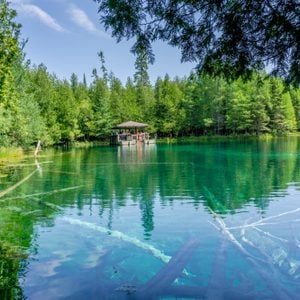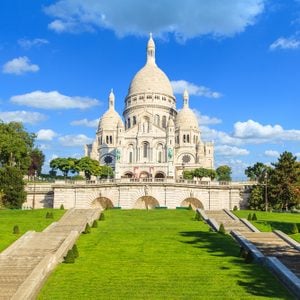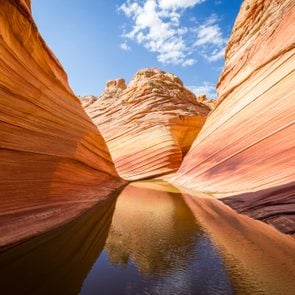How to Experience the 7 Natural Wonders of the World, According to People Who Have Been There
Updated: Apr. 16, 2024
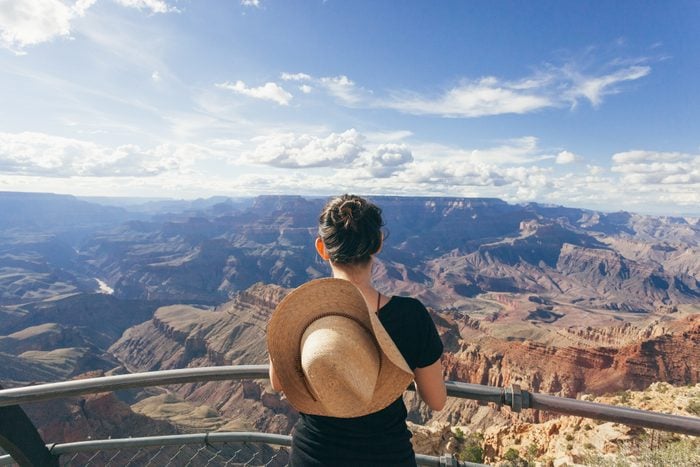
From the highest peaks to the deepest chasms, the 7 natural wonders of the world will make you want to lace up your exploring shoes and head out on an adventure
Our editors and experts handpick every product we feature. We may earn a commission from your purchases.
The natural world is an incredible place. There are soaring mountains and rolling sand dunes, spectacular beaches and shimmering lakes, steaming geysers and bubbling volcanoes—and so much more. Although it’s all truly dazzling, there are a few destinations and sights around the world that stand out from the rest. And the most significant of all are the seven natural wonders of the world.
A consortium of some of the most unique, memorable and iconic places around the globe, the seven natural wonders of the world entice travelers and adventurers to lace up their boots and start exploring. These are the very definition of bucket-list trips, and you’re going to want to make sure you visit these places before they disappear. (Thankfully, you have time.)
Whether you want to take in the most colorful natural wonders, the lesser-known natural wonders or the whole lot of them, you need to know what to expect before you set out to sate your wanderlust. And who better to guide you on your journeys than people who have been there, seen that? We asked travelers who have visited the seven natural wonders of the world to share their experiences and tips—here’s what to know if you want to see these astonishing sights.
Get Reader’s Digest’s Read Up newsletter for more travel, humor, cleaning, tech and fun facts all week long.
What are the seven natural wonders of the world?
Riffing on the wonders of the ancient world (more on those below), the Seven Natural Wonders foundation named the seven natural wonders of the world to highlight earth’s most awe-inspiring spots. (The organization got compilation help from CNN when creating the list.) Unlike the ancient wonders, though, these natural wonders still exist, and you can see them in person today—they’re spread across continents and countries.
The ultimate reason for naming these natural wonders isn’t tourism. It’s the desire to conserve and protect these special places by raising awareness of both their special place in the world and the need for education about the delicate balance of tourism and preservation. The hope is to keep them safe for future generations.
What is the eighth natural wonder of the world?
Unlike the seven natural wonders of the world list, which has been agreed upon by several global organizations and foundations, there is no “official” eighth natural wonder. That doesn’t mean you won’t see many truly worthy natural wonders billed as “the eighth natural wonder,” including Niagara Falls in New York and Canada, Torres del Paine National Park in Chile, Ngorongoro Crater in Kenya and the Pink and White Terraces of New Zealand.
What are the Seven Wonders of the Ancient World?
The concept of the seven wonders is hardly a new one. More than 2,000 years ago, Hellenic travelers and poets in ancient Greece enumerated the world’s seven greatest achievements. Yes, humans have been making “best of” lists for more than two millennia!
These lists date back as far as the fifth century B.C., according to National Geographic, so it might not come as much of a surprise to hear that almost all of them no longer exist, with the exception of one: the Great Pyramid of Giza in Egypt, one of the most breathtaking man-made structures in the world.
These are the original Seven Wonders of the Ancient World:
- Great Pyramid of Giza
- Statue of Zeus
- Hanging Gardens of Babylon
- Temple of Artemis
- Mausoleum of Halicarnassus
- Colossus of Rhodes
- Lighthouse of Alexandria
What are the new seven wonders of the modern world?
In 2001, the New Seven Wonders Foundation created a worldwide poll to name the new seven wonders of the modern world. Mind you, these aren’t “modern” in a 21st-century sense. Some are many hundreds of years old. But you can still visit them, and all are attractions in the modern world.
These are the new seven wonders of the modern world:
- Machu Picchu (Peru)
- Chichén Itzá (Mexico)
- Christ the Redeemer (Brazil)
- Great Wall of China (China)
- Petra (Jordan)
- Taj Mahal (India)
- Colosseum (Italy)
Visit the seven natural wonders of the world
Anyone with a case of wanderlust can visit the seven natural wonders of the world today. I personally have been to two of these incredible places, and I interviewed travelers who’ve visited the other five in person. Their insights underscore the importance of preserving the natural landscape through conservation and education.
Excited to start exploring the world? Read on to find out why these seven spots put the wonder in wonderful.
Grand Canyon
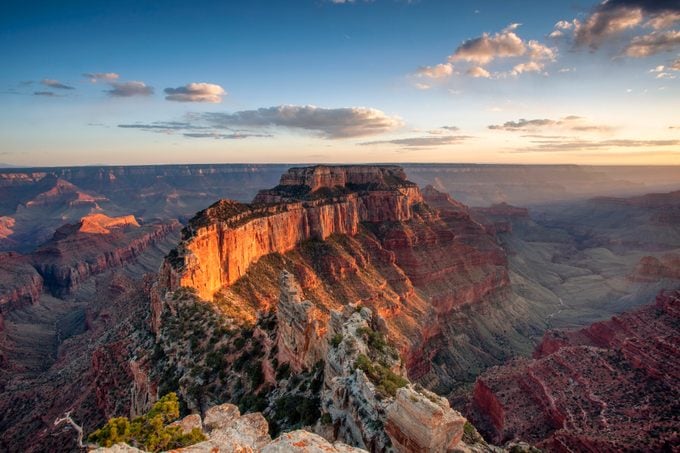
Let’s start with the most accessible of the seven natural wonders of the world for anyone based in the United States: Grand Canyon National Park. One of the most popular national parks in the country, with an estimated 5.9 million annual visitors, the Grand Canyon was formed tens of millions of years ago. A series of extraordinary geologic events created deep chasms and massive rock formations, giving it an average depth of 4,000 feet for its entire 277 miles.
“It’s truly awe-inspiring. Because I could drive to the Grand Canyon, I wasn’t quite prepared for how completely breathtaking it was when I arrived,” says Mark Sullivan, a travel writer and editor. “I had driven from Sedona, in the summer, where it was very hot, and the Grand Canyon had trees, shade and a breeze, which made it feel completely different from other spots in the Southwest.”
Something about the way it’s situated makes it seem endless, adds Sullivan, who also told me that he was amazed by how quickly the scenery changed when doing even a short hike around the popular South Rim. “Every time I looked up, there was another view that was unlike anything I had ever seen,” he says. “I was completely captivated.”
Plan a visit: Summer is the busiest time at the Grand Canyon, and July and August are also the hottest months. Try visiting in the shoulder season—late spring and early fall—when you’ll have temperate weather and fewer crowds. For a glamping experience under the stars (don’t worry, there are four-poster beds, indoor plumbing and wood-pellet stoves, so you won’t exactly be roughing it), head just 25 minutes from the South Rim to the luxury tents of Under Canvas Grand Canyon.
Northern Lights
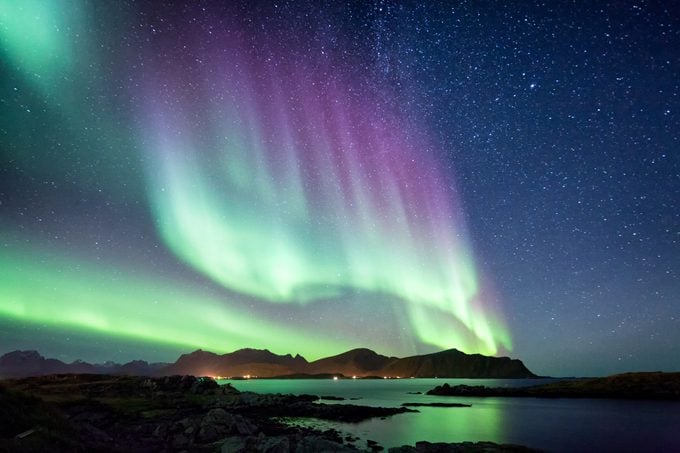
Unlike the wonders that are located in a single destination, the aurora borealis (aka the Northern Lights) is a phenomenon that occurs in multiple destinations above the Arctic Circle and occasionally even in spots across the Northern United States. It’s a technicolor light show that definitely creates an argument for winter travel.
I saw the dazzling aurora borealis on a trip up the coast of Norway in February. Yes, it was cold. Very, very cold. And the first time I spotted the lights, just to the north of the Arctic Circle, they were a faint green ghost in the distant sky, not the light show I had imagined. But several days later, farther north and many miles above the Arctic Circle, on the completely frozen Lofoten Islands, snowmobiling in the pitch black and worrying about my contacts freezing to my eyes (did I mention it was cold?), I had a completely different experience.
Everyone in my group turned off their motors and their lights. There was complete darkness, and then I looked up to see dancing helixes of purple and green looping through the cosmos. The inky sky was filled with galaxies of stars, and the entire sky seemed to bend. It was truly a once-in-a-lifetime experience. And yes, while the glowing Northern Lights ribboned around the velvet darkness, I forgot about how cold I was.
Plan a visit: If you want to see the Northern Lights, you have options: Visit Alaska, Finland, Canada, Iceland or other northern countries. I had an awe-inspiring view of them in Norway, and I’d recommend the trip to anyone.
The northernmost point of Europe, right on the border of Russia, is really, really cold in winter (like –16 degrees in the sun). But it has to be cold for the Snowhotel Kirkenes to welcome visitors to its ice-sculpted rooms. I’ve stayed here, and I didn’t love spending the night on ice. Instead, choose to stay in one of the property’s cozy glass-roofed Gamme Cabins, where you can spot the ethereal vision of the aurora borealis from your bed.
Mount Everest
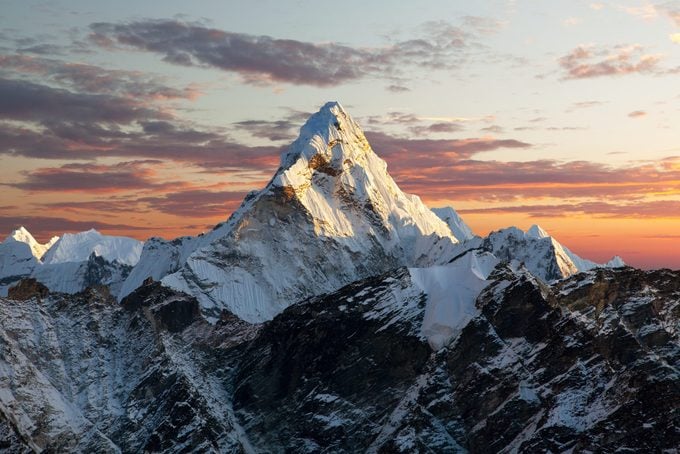
Towering at 29,000 feet above Tibet, Mount Everest (locally known as Chomolungma, which means “the goddess mother of the world” in Tibetan) is the pinnacle, quite literally, for many mountain climbers and adventure travelers. It’s also dangerous and often fraught with inexperienced climbers who have made a “mess at the top of the world,” according to some sources. But the scenery is beyond compare, even from base camp.
“After many dusty hours in a jeep passing through remote Tibetan villages and over several high passes, we finally arrived at Rongbuk monastery,” recalls Nick Fulford, who has spent the past 20 years leading tour groups around the world. “The views along the way of the Himalayas stretching into the distance have been tantalizing, but now, at the head of the valley, bathed in soft evening sunshine, is what we’ve been waiting for: Chomolungma in all her glory.”
After dismounting at base camp, Fulford walked very slowly up to a viewpoint, breathing heavily in the thin air. “At 5,100 meters, we stop and stare at this stunning mountain as the colors of the setting sun change the mood constantly,” he says. “Not far from here, we were surprised to see a small hill in the moraine, which acts as a memorial for lost climbers. These include legendary explorers such as Mallory and Irvine but also climbers from the current season who made the ultimate sacrifice in order to fulfill their adventurous spirit.”
As Fulford notes, the peak isn’t on everyone’s bucket list, and that’s OK. Just seeing the immensity of the mountain in person is enough. “For me, this was as close as I wished to be to this iconic mountain. This was my summit,” he says. “I feel privileged to have had this moment to enjoy the raw natural beauty whilst appreciating the dangers of such a harsh environment.”
Plan a visit: Climbing Everest is a major undertaking, one that not only takes a great deal of physical stamina and training but also costs anywhere from $10,000 and (way) more to reach the summit with the necessary guides, gear and oxygen. Visiting base camp is less of an undertaking but still requires advanced planning and physical agility. In other words, this isn’t a trip to take lightly. But if you think you’re up for it, there are numerous multiday treks and tours, most of which depart from Kathmandu.
Paricutin Volcano
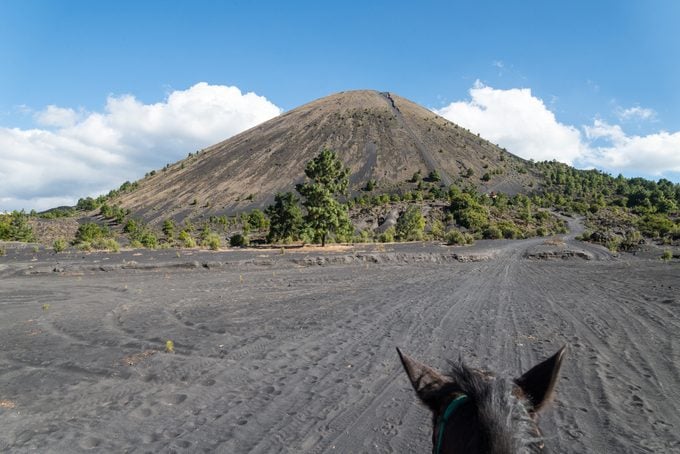
As the youngest volcano on earth, Paricutin fascinated scientists back in 1943 as they witnessed the birth of a volcano for the first time in this century. This lesser-known of the seven natural wonders of the world is hard to reach and rarely visited by travelers, but it offers an intriguing visit for intrepid explorers willing to venture off the tourist trail in Mexico.
“A visit to this volcano requires a grueling hike or an uncomfortable horse ride from a nearby Purépecha community, and as volcanoes go, it is perhaps a little underwhelming,” says Louise France, a Welsh mountain leader and snowboard instructor who has visited Paricutin several times. “It’s not a particularly large volcano, and there’s no magma to be seen in the depths of the crater. But what makes this site special for me and for many locals lies nestled amongst the lava field at the base of the volcano.”
During its eruption, lava destroyed two nearby towns, leaving a single structure standing: the church of San Juan Parangaricutiro. “From a distance, the church spire can be seen standing incredulously amongst the blackened lava field,” she says. “The seemingly miraculous nature of the building’s survival has resulted in the church becoming a major pilgrimage site.”
She didn’t know that before her first visit, though. Only after arriving did she learn just how important the church is. “Mexicans had traveled far and wide to see this holy site,” she recounts. “I was also very aware that this was not a destination for most Westerners traveling to Mexico, with little to no English being spoken. I felt truly off the beaten path. I was lucky enough to visit Paricutin several times, and I always enjoyed making the exploration to both the church and the volcano itself.”
The short scramble to the crater summit wasn’t too strenuous, she told me, adding that running down the volcano elicited peels of laughter.
Plan a visit: Paricutin is not an easy site to reach, and there is no modern tourism infrastructure in place. While this is wonderful from a preservation perspective, it makes a trip here difficult to plan. The closest international airport is Morelia, a 2.5-hour drive. And as France mentions, there are no roads here, so you’ll need to hire a tour guide and hike or horseback ride to the site.
Victoria Falls
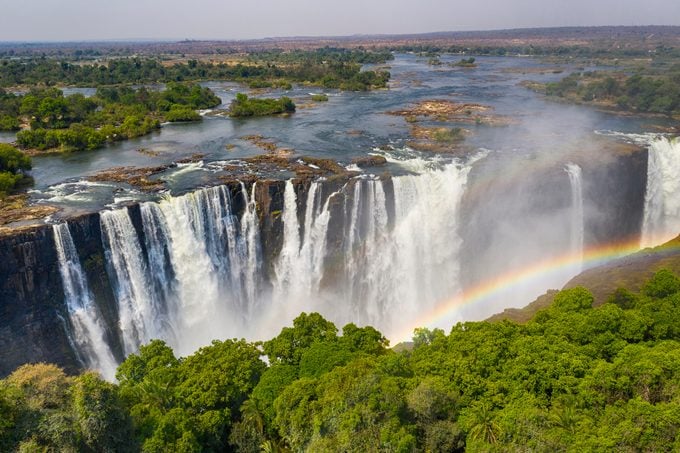
Known as Mosi-oa-Tunya, or “Smoke That Thunders” in the local Lozi language, these massive waterfalls are a sight to behold, and I’ve been lucky enough to visit them three times now over the past two decades. More than twice the height of Niagara Falls, Victoria Falls in southeastern Africa (one of the places I most love to visit) straddles the Zambezi River running between Zimbabwe and Zambia and measures in at a whopping 355 feet tall and more than 5,500 feet wide.
I’ve been able to visit in different seasons—spring, summer and winter. I’ve experienced everything from visiting an island in the middle of the river during the December “dry” season (I had a romantic lunch with my husband while hippos wallowed around us and the falls plunged into the river just upstream) to getting drenched with my daughter when the falls were at their pounding apex in June. All of it was spectacular, not just because Victoria Falls is so epically proportioned but also because of the natural world bordering it.
On a small, motorized boat on my June trip, we watched tiny, colorful birds called bee-eaters dash in and out of the muddy river walls as they built nests. After, I joined a ranger for a hike into an adjacent national park, where I watched some of the remaining white rhinos in Zambia peacefully nibble high grass.
On a May trip, a helicopter “flip” (as flights over the falls are terrifyingly called) showed me how vast the watery wonder is, including the secluded natural pool where intrepid visitors can take a dip. On foot, on the wettest visit, droplets drenched my clothes while rainbows filled the misty air, truly giving the waterfalls a magical glow. I can’t wait to return again to see more wonders of Africa’s beautiful “smoking” falls.
Plan a visit: It’s easy to fly into Livingstone International Airport on the Zambian side of the falls, where you’ll be able to reach the majority of lodges and activities offered here. My favorite spot to stay at Victoria Falls is also the property with the best location, the Royal Livingstone Victoria Falls Zambia Hotel by Anantara.
The luxury property perches right on the Zambezi River, with a cocktail bar set on a deck with views of the mist from the falls on one side and resident gentle zebras resting on the green lawn on the other. Being able to follow an easy walking path to arrive at Victoria Falls from the hotel in just a few minutes may make this the easiest of the seven natural wonders of the world to visit (after you fly to Africa, that is).
Great Barrier Reef
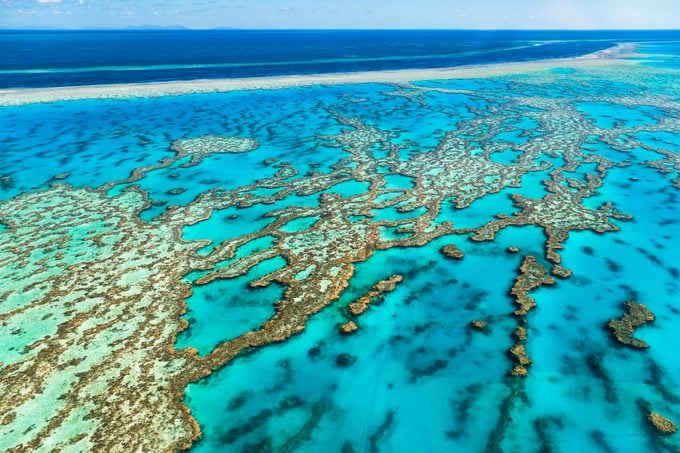
This 1,429-mile ecosystem is the largest living thing on the planet and a stunning deep-sea sight. It’s so enormous, astronauts could even see it from outer space. This natural wonder wows with its dazzling array of fish, mollusks, dolphins, sharks and turtles.
Intrepid traveler and AwardWallet editor Ryan Smith visited the storied reef for a honeymoon getaway. “It’s one of the world’s most interesting places, and I’ll never forget scuba diving here on my honeymoon,” he says. “We saw countless fish, beautiful coral and even an octopus that quickly buried itself in the sand to hide. Many people dream of visiting this place, and seeing it up close made it even more magical.”
For other honeymooners, a romantic spot worth seeking out is located in the Great Barrier Reef of the Whitsundays in Australia: The Heart Reef is 55 feet in diameter and one of nature’s best mysteries. The coral formed into the shape of a heart by itself over time and was discovered in 1975 by a pilot. By air is still the best way to visit—the only way to see the heart shape is by plane or helicopter. (It isn’t a surprise that a lot of those flights turn into in-air proposals!)
Plan a visit: You can’t go wrong with a stay at the InterContinental Hayman Island Resort, which is positioned right at the heart of the Great Barrier Reef. Surrounded by verdant cliffs, white-sand beaches and celestial-blue sea, the resort’s 182 rooms, suites and villas will immerse you in the spectacular scenery of the area and give you easy access to explore the watery wonders here.
Harbor of Rio de Janeiro
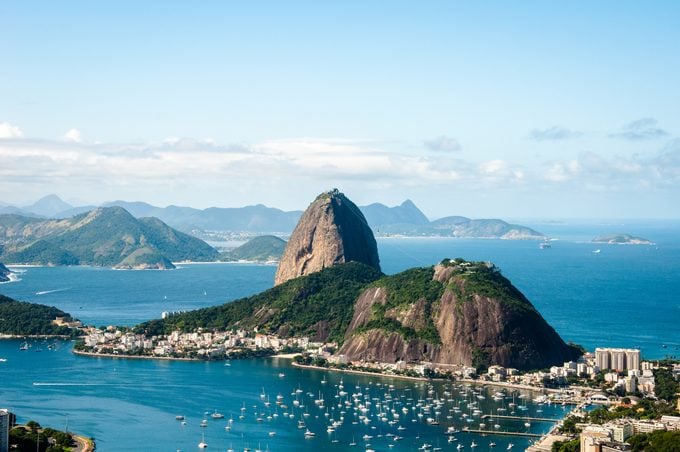
Almost 5,400 people per square kilometer are packed into urban Rio de Janeiro, the storied city on Brazil’s golden coast, making it one of the most populated places on earth. It’s also one of the most popular travel destinations in South America, due in no small part to its breathtaking harbor, also known as Guanabara Bay. The turquoise bay is surrounded by a stunning beach and framed by granite monolith mountains, including iconic Sugar Loaf Mountain, where the Christ the Redeemer statue stands watching the entire city. Just past the harbor, numerous islands dot the water.
“While the beaches might be your first thought [when you picture Rio], my fondest memories of the harbor come from above,” says Smith, who has visited the area multiple times. “The Mirante Dona Marta, or Dona Marta Lookout Point, in the Santa Teresa neighborhood offers spectacular views of the whole harbor, plus Christ the Redeemer. From this height, you can see everything, and that view is what comes to mind when I think of Rio de Janeiro.”
Plan a visit: The Sheraton Grand Rio Hotel & Resort sits directly on the beach and offers a tropical resort setting in busy Rio. You’ll have direct access to the sand and surf, plus access to a large pool, landscaped gardens and a range of restaurants and spa experiences to truly make you feel like you’re in a beach oasis.
About the experts
- Mark Sullivan is a travel writer and editor.
- Nick Fulford is an expedition leader who has spent 20 years leading tour groups around the world.
- Louise France is a tour guide for an adventure company, a mountain leader and a snowboard instructor.
- Ryan Smith is an editor with AwardWallet who’s on a mission to visit every country in the world. He has only 10 more to go.
Sources:
- Seven Natural Wonders: “7 Natural Wonders of the World”
- National Geographic: “Seven Wonders of the Ancient World”

